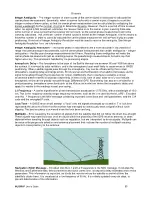
Glossary
98
MLGPS-P
User's Guide
Time Delay
‒ The GNSS receiver has a clock. When it receives the satellite's signal, with the
time signal
, it
compares the time the signal was broadcast by the satellite to the time that it received the signal according to
its own clock. The difference in time is the
time delay
, essentially the transit time of the signal from the satellite
to the receiver. The time delay is used in the calculation of the pseudorange. It contains errors, as there are
slight differences between and inaccuracies of the satellite's clocks and the receiver's clock.
Time Signals
‒ Each satellite has an atomic clock onboard. When the satellite broadcasts its signal, it includes
the time that the signal is broadcast according to its atomic clock. This is the
time signal
.
Trilateration
‒ A geometric method of determining position by measuring distances to points with known
coordinates.
Tropospheric Error
‒ The Troposphere is the layer of the Earth's atmosphere that begins on the surface and
extends to around 60 km above the surface. It can cause delay in the measurement of satellite signals, mostly
due to humidity and atmospheric pressure. It can be mitigated by
Differential GPS
.
WGS84
‒ The World Geodetic System (WGS) is the standard global reference system/geographic coordinate
system used for GPS. It was last revised in 1984, hence WGS84. It provides a coordinate system, datum and
geoid that allow for accurate 3D positioning.

































